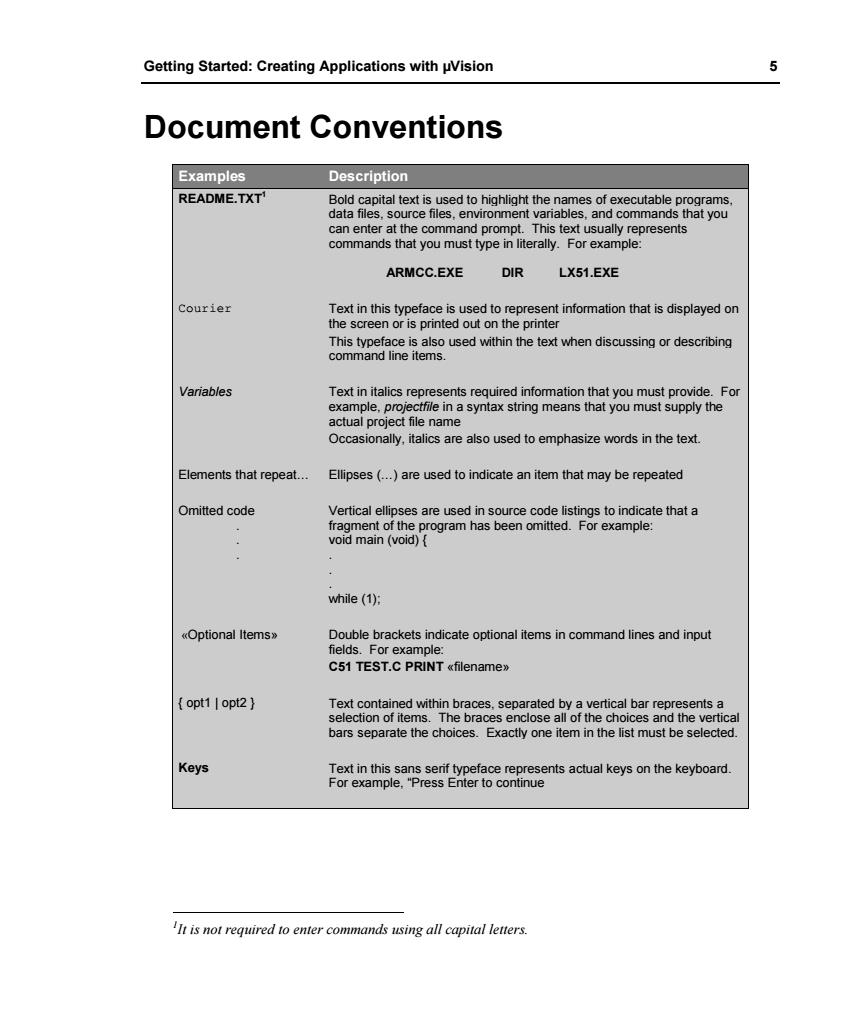正在加载图片...

Getting Started:Creating Applications with uVision 5 Document Conventions Examples Description README.TXT' Bold capital text is used to highlight the names of executable programs, data files,source files,environment variables,and commands that you can enter at the command prompt.This text usually represents commands that you must type in literally.For example: ARMCC.EXE DIR LX51.EXE Courier Text in this typeface is used to represent information that is displayed on the screen or is printed out on the printer This typeface is also used within the text when discussing or describing command line items. Variables Text in italics represents required information that you must provide.For example,projectfile in a syntax string means that you must supply the actual project file name Occasionally,italics are also used to emphasize words in the text. Elements that repeat... Ellipses(...)are used to indicate an item that may be repeated Omitted code Vertical ellipses are used in source code listings to indicate that a fragment of the program has been omitted.For example: void main(void){ while (1); Optional Items》 Double brackets indicate optional items in command lines and input fields.For example: C51 TEST.C PRINT filenamex opt1 opt2 Text contained within braces,separated by a vertical bar represents a selection of items.The braces enclose all of the choices and the vertical bars separate the choices.Exactly one item in the list must be selected. Keys Text in this sans serif typeface represents actual keys on the keyboard. For example."Press Enter to continue It is not required to enter commands using all capital letters.Getting Started: Creating Applications with µVision 5 Document Conventions Examples Description README.TXT1 Bold capital text is used to highlight the names of executable programs, data files, source files, environment variables, and commands that you can enter at the command prompt. This text usually represents commands that you must type in literally. For example: ARMCC.EXE DIR LX51.EXE Courier Text in this typeface is used to represent information that is displayed on the screen or is printed out on the printer This typeface is also used within the text when discussing or describing command line items. Variables Text in italics represents required information that you must provide. For example, projectfile in a syntax string means that you must supply the actual project file name Occasionally, italics are also used to emphasize words in the text. Elements that repeat… Ellipses (…) are used to indicate an item that may be repeated Omitted code . . . Vertical ellipses are used in source code listings to indicate that a fragment of the program has been omitted. For example: void main (void) { . . . while (1); «Optional Items» Double brackets indicate optional items in command lines and input fields. For example: C51 TEST.C PRINT «filename» { opt1 | opt2 } Text contained within braces, separated by a vertical bar represents a selection of items. The braces enclose all of the choices and the vertical bars separate the choices. Exactly one item in the list must be selected. Keys Text in this sans serif typeface represents actual keys on the keyboard. For example, “Press Enter to continue 1 It is not required to enter commands using all capital letters